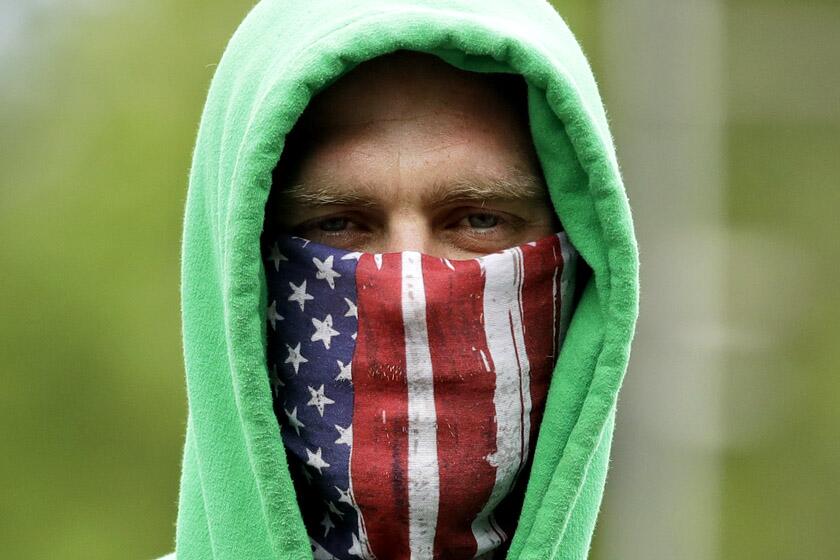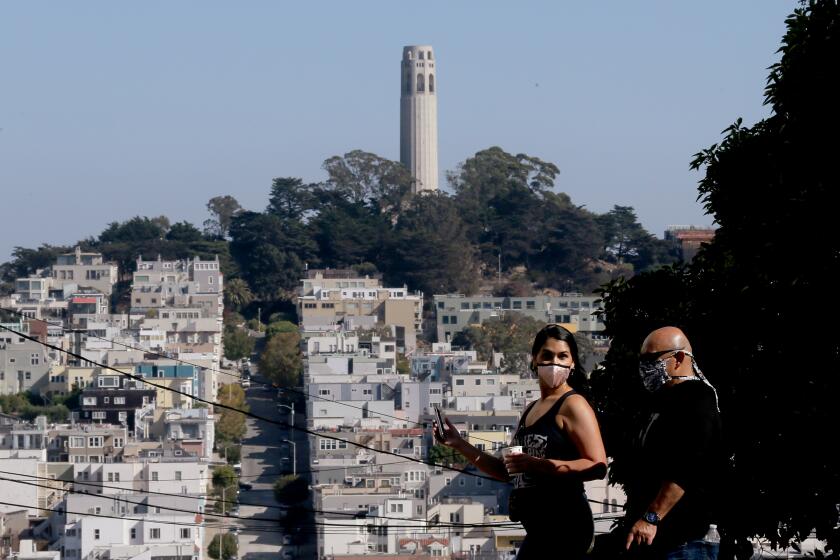A winter surge in COVID-19 cases seems inevitable. Can we stop it?

Temperatures are dropping, nights are growing longer, the holidays are nearing, and the science is clear: The pandemic is far from over. A long, dark winter awaits.
The number of new coronavirus cases in the United States each day has ballooned from fewer than 40,000 in early September to more than 100,000 in early November. The U.S. now confirms more cases in a single day than China has reported altogether since the pandemic began.
“We may be turning a corner, but not in a good way,” said Julie Swann, an expert in healthcare systems at North Carolina State University.
Although a winter surge of COVID-19 is now unavoidable, experts caution that the number of infections and deaths it will bring is not yet written in stone — and its magnitude depends on what we do next. Hundreds of thousands of lives may hang in the balance.
“Saying a surge is inevitable may sound like fatalism,” said William Hanage, an epidemiologist at Harvard’s T.H. Chan School of Public Health. “But just because some surge of some size is inevitable, it doesn’t mean the size is inevitable.”
If the United States continues to relax social distancing restrictions and mask-wearing requirements, as many as 500,000 more Americans could die of COVID-19 between now and the end of February, according to scientists at the Institute for Health Metrics and Evaluation at the University of Washington. That’s on top of the roughly 240,000 COVID-19 deaths the country has absorbed already.
Even if we take substantial collective action, the number of additional deaths from the coronavirus could top 100,000 between now and Feb. 28, the IHME researchers said.
“We are past the point of being able to get the virus under control,” said Christopher Murray, director of the institute and leader of the modeling work. “There is too much of it out there.”
If nearly all Americans would wear face masks when they leave their homes, they could save over 100,000 lives by the end of February, a study says.
Scientists have warned for months that the virus that causes COVID-19 could be seasonal, spreading more easily in the cold winter months like influenza and the viruses that cause the common cold.
Experience has shown that SARS-CoV-2 is capable of spreading even when temperatures soar. This summer, outbreaks occurred at an overnight camp in Georgia, a hockey rink in Florida and prisons in California. But experts said there are myriad reasons why the coronavirus would spread even more rapidly in the winter.
Some are due to the biology of the virus itself. Studies have shown that SARS-CoV-2 has more stamina in cold conditions than in warm ones. When exposed to temperatures of 80 degrees Fahrenheit and 65% relative humidity, more than half of viral samples break down in just 90 minutes. But when the temperature drops to around 50 degrees, with 40% relative humidity, the virus can survive on surfaces for more than 24 hours.
Cold weather also affects human behavior. When the temperature falls, it becomes less comfortable to spend time outdoors, where the risk of infection is significantly lower than it is inside.
“The virus loves indoor, poorly ventilated spaces,” Hanage said. “Good ventilators could be helpful, but it is not as good as outside.”
Epidemiologists are also deeply concerned about the coming holiday season, and the ensuing family gatherings at which people from different households are likely to be indoors and unmasked for hours at a time. They fear these celebrations could kick outbreaks into higher gear, and that would be particularly dangerous for older family members who face a heightened risk of developing a severe case of COVID-19.
Can you have Thanksgiving during the COVID-19 pandemic? Researchers have created an interactive map that estimates the risk you’ll face in any county.
“Mask use indoors is extremely important, especially if you are having a multigenerational family meal,” Hanage said. “But of course, people have to remove their masks to eat.”
Recent surges in coronavirus cases have caused England, France, Greece, Spain and other European countries to reinstate lockdowns. Experts say that’s further evidence that a winter surge in the U.S. is all but certain.
Around the world, the pattern of coronavirus infections has largely mimicked the usual trajectory of pneumonia outbreaks, with a high concentration of cases in South America over the summer followed by a spike in Europe that starts about a month before the one in the United States, according to IHME researchers.
Although the arc of pneumonia cases in the U.S. varies from state to state, it generally hits a low in August and a high in the first weeks of February, Murray said.
The sort-of silver lining is that over the last eight months, physicians have become much better at treating patients who are hospitalized with COVID-19. That means more people will survive. Nonetheless, a COVID-19 patient who survives a hospital stay is still taking up a bed that won’t be available to a patient fighting cancer or trying to recover from a stroke — or waging their own battle against the coronavirus.
“We’re already seeing some hospitals fill up, and they are just going to keep filling up,” said Dr. Michael Mina, an infectious disease specialist at Harvard.
All this may make you feel like giving up. If a winter spike is already underway, is it even worth trying to fight it? Mina and others say the answer is an emphatic yes.
A coronavirus outbreak tied to a wedding reception caused 177 infections and 7 COVID-19 deaths. It shows why health officials are nervous about holiday gatherings.
Waiting for herd immunity to arrive — either via an effective vaccine or through natural exposure to the virus — is not the answer, Mina said. It’s like watching an enemy drop bombs on our homes and thinking, “Well, they’ll run out of bombs eventually.”
“If this was an actual war that was killing 200,000 people, we would be building bombers, we’d be building missiles,” he said.
A missile won’t stop the coronavirus, but the widespread use of epidemiological tools might: Rapid tests that can be administered at home would be a game changer. So would robust contact tracing and a concerted effort to resist virus fatigue and remain socially distanced from those who are not in your household.
Simply getting people to wear masks every time they leave their homes would reduce infection rates by 25%, experts say.
“Informed infection control does not mean bleaching all your groceries and not going to the grocery store,” Hanage said. “It does mean only going indoors where there is high mask compliance and avoiding the three Cs: close contact, closed spaces and crowds.”
Fauci says that, as the coronavirus surges in the U.S., we may have to put off longed-for activities for another year or more.
And here lies a small glimmer of hope: If we commit to living differently with the virus, then we might just alter its projected course, said Nicholas Reich, a professor at the University of Massachusetts in Amherst who has been developing models of the virus’ spread for the Centers for Disease Control and Prevention.
“It’s really hard to forecast an outbreak, especially a pandemic, months in advance, because so much depends on how we as a society respond,” he said. “The only thing that is inevitable here is that human behavior is hard to influence, and fatigue is a real thing.”










